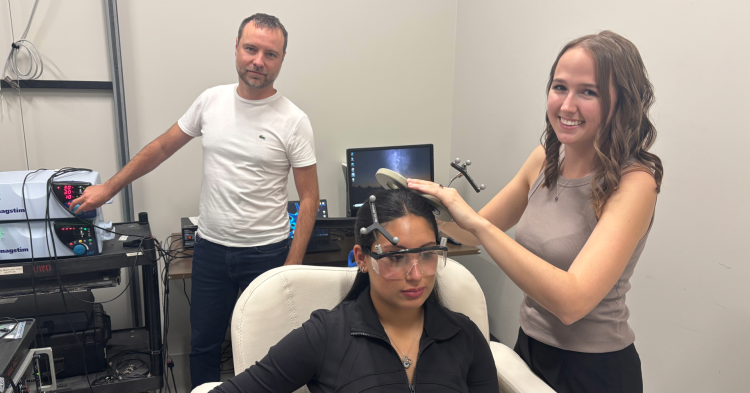For fourth-year neuroscience student Madison Henderson, the most rewarding part of the summer has been the chance to contribute to meaningful research with real-world impact.
"It's been about building toward that higher outcome," Henderson said. "It's hard to see it day to day, but through all the little moments, I feel like I'm helping make a difference."
What started with a first-year psychology class quickly transformed into a long-term passion. Now, as a neuroscience student in Schulich School of Medicine & Dentistry, she focuses on understanding chronic pain and the different ways it can be researched.
Chronic pain affects nearly one in five Canadians. It is the leading cause of years lost to disability worldwide and comes with a significant economic toll, costing the Canadian economy upwards of $40 billion per year.
Through Western's Undergraduate Summer Research Internships (USRI) program, Henderson is contributing to a large-scale multi-year study, overseen by Western professor and William and Lynne Gray Research Chair Siobhan Schabrun, examining the brain and body mechanisms that can help predict chronic pain before it occurs.
"A lot of people don't think about chronic pain as a disease in its own right, and we don't talk about it very much," said Schabrun, a professor in Western's Faculty of Health Sciences. "There's often a lot of stigma associated with it, and I think as a society we need to recognize it more readily. It's a really huge problem."
Studying pain before it becomes chronic
The research project investigates how people's movement patterns change when experiencing pain. From this data, the goal is to reliably predict who may develop chronic pain later.
"If you have a sore ankle, you'll move differently by limping. But over time, as that pain becomes more chronic, these changes in movement have the potential in and of themselves to perpetuate more pain," said Schabrun, the study's principal investigator.

Madison Henderson plans to continue her research with the Schabrun lab beyond her USRI project. (Ali Shahan Butt/Western News)
Using tools like electroencephalography (EEG) and transcranial magnetic stimulation (TMS), Schabrun, Henderson and their team is identifying potential biomarkers, measurable indicators that signify the risk of chronic pain.
To artificially induce pain in participants, the study uses a protein called nerve growth factor (NGF), which is naturally produced by the body when experiencing pain. By exposing participants to small amounts of NGF, researchers simulate lasting pain in a safe and controlled way.
Henderson then helps collect data from participants by tracking changes in wrist movements as well as recording brain activity. Each participant takes part in four lab sessions, lasting up to three hours each, making recruitment and communication essential.
"I thought I was a good communicator," Henderson said. "But this project really pushed me. You need to explain complex procedures clearly and help people feel comfortable with what's happening, which is especially important when they're being asked to voluntarily experience pain."
It inspired Henderson's USRI project, which is now focussed on the importance of public-facing science communication. She's creating an infographic-style piece to explain the research project's pain model, NGF, and how it is used in the study.
How USRIs support undergraduate-led research
Henderson's experience was made possible through the USRI program, a Western-funded initiative to provide undergraduate students with enriching research opportunities throughout summer.
"For a lot of undergrads, like Madison, these USRI experiences are their first opportunity to really immerse themselves in research," said Schabrun. "It helps them see what it's like and whether it might be of interest to them as a future career path."
The program allowed Henderson to not only contribute to an impactful health study, but also to take ownership of her own little piece of it.
"I really wanted to seize that opportunity to have an established internship and take on my own project rather than just volunteering in the lab," she said.

Madison Henderson and fellow researchers utilize EEG and TMS technology to conduct research on chronic pain. (L to R) Project supervisor Arnaud Duport, Noran Al-Momen and Madison Henderson.
In addition to direct mentorship, USRI participants receive access to various professional development sessions, improving their skillsets and supporting their academic and career development.
Schabrun said she believes USRI programs are vital to both student growth and research progress.
"It allows students to hone their critical thinking skills, scientific writing skills and all of those other pieces of the puzzle that you need if you're interested in research as a career path," she said.
Research with real-world potential
Chronic pain is often considered a global crisis, posing significant socioeconomic impact. With current treatments often falling short, the chronic pain epidemic has contributed to a range of societal challenges, including the rise in opioid abuse.
Henderson believes prevention is a crucial goal for researchers to pursue.
"Right now, we're trying to treat symptoms with general treatments that do not work for everyone. But if we can identify these biomarkers our research is targetting, hopefully we can create preventative treatments to minimize the effects of chronic pain much earlier," she said.
Henderson hopes to continue using her neuroscience skills to drive change for those suffering.
"I just hope I can help in making some sort of difference."











